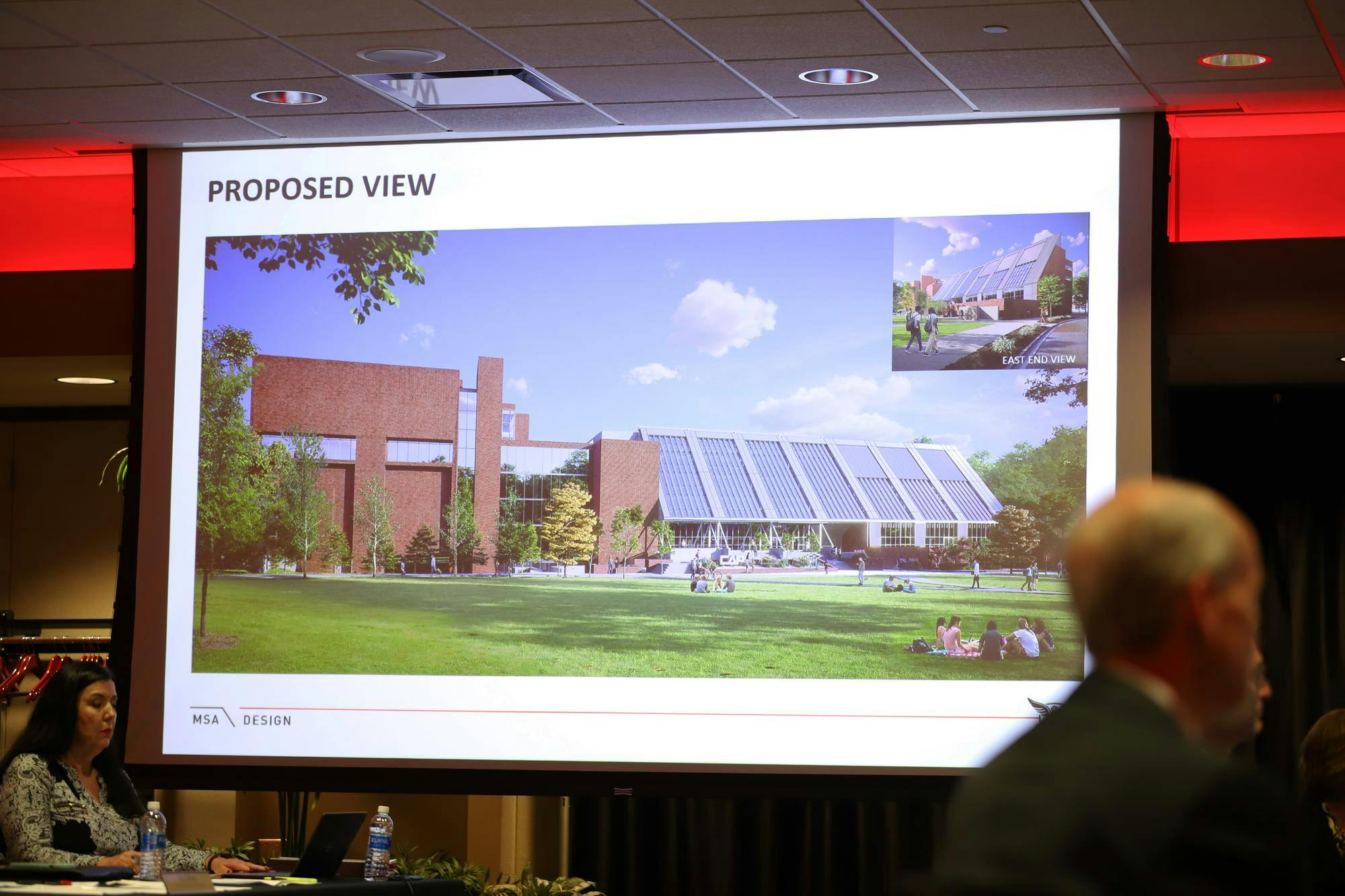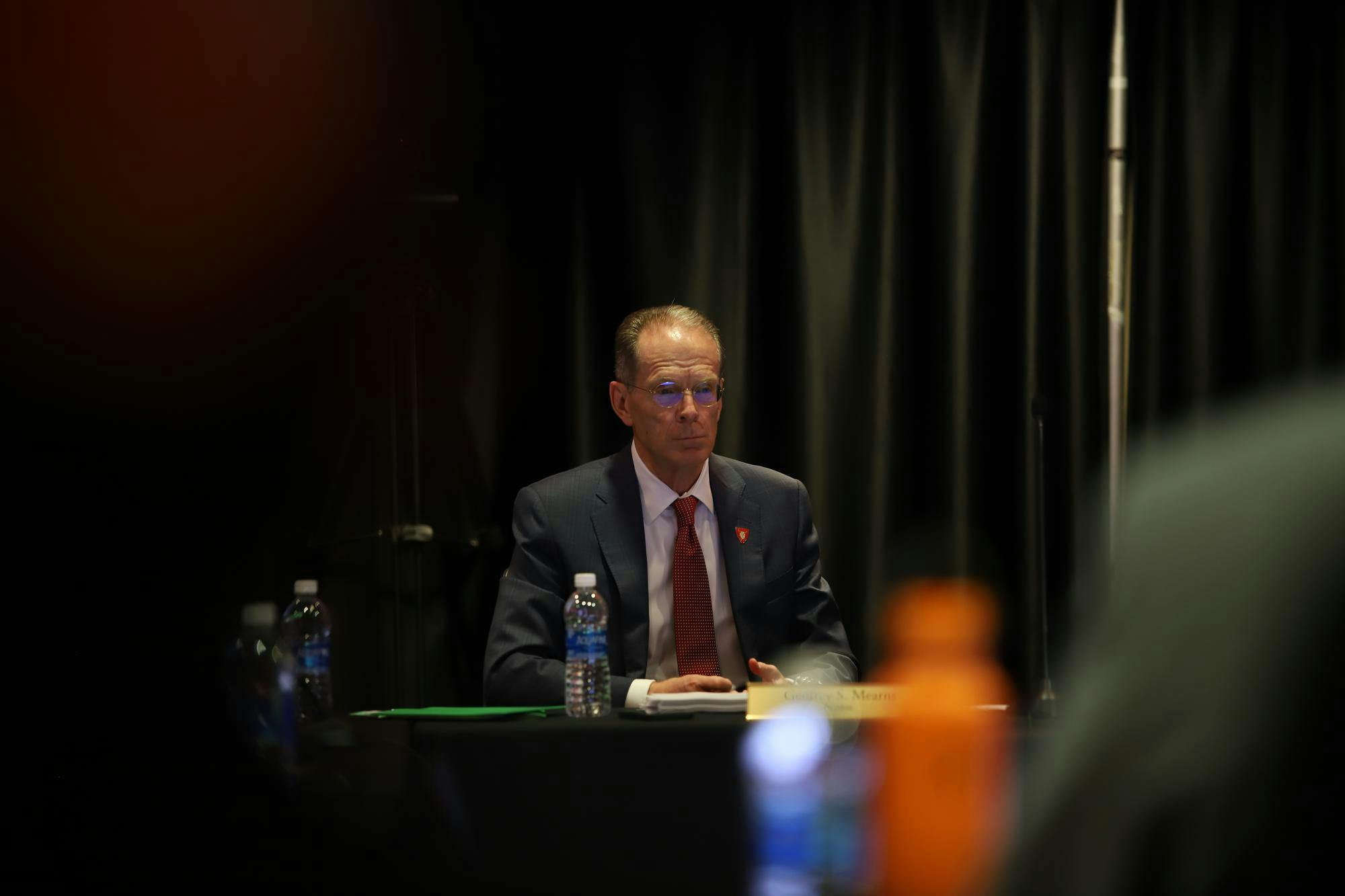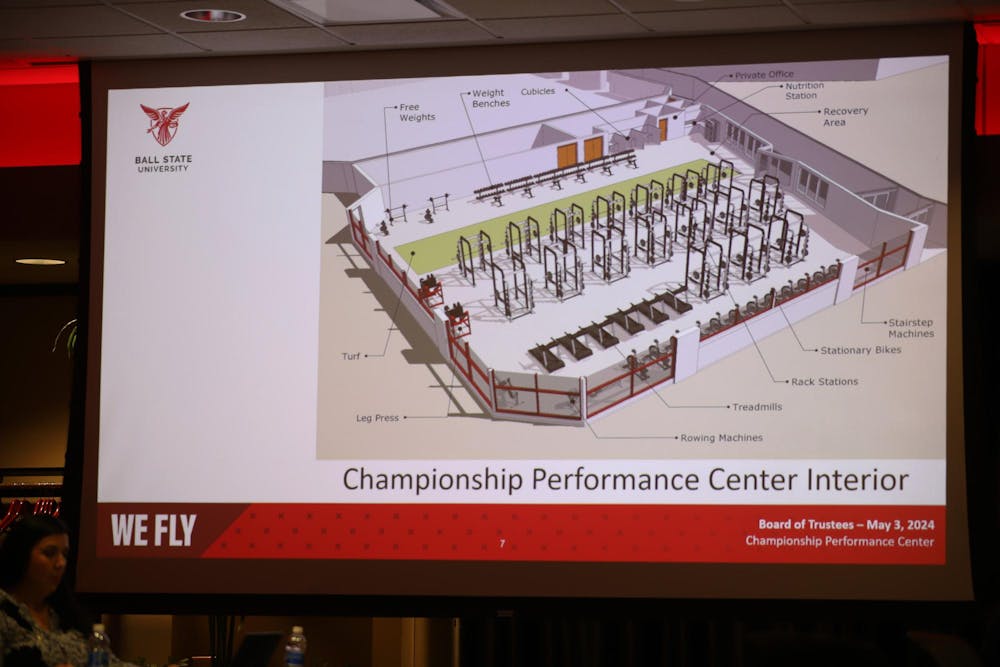The Board of Trustees met May 3, revealing plans for an upcoming renovation of the College of Architecture and Planning (CAP) building, plans for an upcoming sports performance training center, changes in the university core curriculum and many hiring and human resources developments being made in the upcoming months.
The Championship Performance Center
Director of Athletics Jeff Mitchell and Associate Vice President for Facilities Planning and Management Jim Lowe announced a $7.8 million training facility to be opened near gate two of Worthen Arena in the winter of 2026.
The new center will be named the Eric Foss Performance Center.
Eric Foss is an alumnus of Ball State and previous CEO of Pepsi Bottling Co. His wife, Kim Foss, is a previous student-athlete herself.
According to Mitchell, 18 of the 19 athletic teams will have access to this facility. He said this equates to around 80 percent of the student-athlete population.
Mitchell said the current plan for the gym will hold “state of the art” technology and workout equipment, as well as a nutrition bar and recovery area. It will be attached to the current Shondell practice center and feature multiple large windows to allow for natural light.
The current timeline includes donors approving the design and will begin construction in Jan. 2025.
“We look forward to the coming months and we continue to develop what this facility will look like and we start to implement this transformative opportunity for our student-athletes,” Mitchell said.
Upgrades to the College of Architecture and Planning Buildings
Updates were provided about the changes being done in the R. Wayne Estopinal (CAP) building. This was originally approved in May of 2023 as a part of the north campus revitalization project.
The architecture firm, MSA Design, is completing a $20 million project that plans to make large changes to the main parts of the CAP building. The east side of the building will remain available for future renovations.
The current focus of the renovations centers around student and faculty requests for more studio and office spaces.
This new project will create an anticipated three new studio spaces, update the historic preservation lab, create new gender-inclusive restrooms, add a lactation room, add entry elements to the main atrium space of the building and overall improve the accessibility and sustainability of the building.
Construction of the project is set to begin Dec. 2024
Dean of CAP David Ferguson said construction would be taking place “in chunks,” and students will be able to use the cleared studio spaces hopefully by June 2026 when substantial renovations are complete..
Additionally, a project and art display in the building are prepared to potentially become a makeshift studio space. Students will be potentially able to use other locations on campus, alongside places in Downtown Indianapolis and Muncie, to have class.
“We think we can do it without missing a beat on the educational front,” Ferguson said.

Changes to the University Core Curriculum
Provost and Executive Vice President for Academic Affairs Anand Marri and Vice Provost for Academic Affairs Kecia McBride shared plans for a change in the University Core Curriculum that is anticipated to launch for the fall 2026 semester.
McBride and Marri sourced that the last update to the core curriculum was in 2010, prompting a refresh to the wants and needs of students.
The main change in the curriculum is the creation of what is currently called “beneficence pathways.”
These are transdisciplinary classes that extend across different colleges under an overarching theme that provides students the opportunity to use their time in the core curriculum to learn about something they are more interested in.
Examples of these pathways given are social responsibilities, cultures and values, sustainability, innovations, global connections and personal and financial wellness.
Changes also include slight adjustments in current classes and the implantation of freshman seminars.
These changes are being made with the hopes of increasing enrollment and transfers. Marri and McBride sourced the changes of having 100 percent of high schools in the state offering Indiana College Core (ICC) dual credit classes.
McBride said this change will make it easier for students taking these ICC classes in high school to apply them to their education at Ball State while still engaging in first-year classes.
“We want to prepare [first-year students] for fulfilling careers, meaningful lives. It’s also important that we align with the state mandates on the 30 credit hours college core,” Marri said.
Retiring and Emeritus/Emerita Faculty
Vice President for Business Affairs and Treasurer Alan Flin presented seven faculty members for approval for retirement and promotion to Emeritus/Emerita status.
The faculty included:
- Stephanie Wilson- Assistant Lecturer and online program coordinator in the Center for Information and Communication Sciences.
- Elizabeth Kurisack - Associate Professor of Spanish
- Seonmi Lee - Academic Adviser for first-year students
- Kamal Islam - Professor of Biology
- Phil Shaffer - Director of Enterprise Information Systems
- Jim Lowe- Associate Vice President for Facilities Planning and Management
- Bob Kester- Director of the Center for Energy Research, Education and Service and Professor of Architecture
Changes to the People and Culture Work Plan
Based on survey results from university employees, Associate Vice President for People and Culture Derrell Clark shared that plans were being made at “local levels” to create positive changes in the staff onboarding and engagement process.
This includes plans for new professional development training, changes to the employee management systems and the creation of action plans for individual colleges at the university.
According to Clark, a new contract has been acquired for a new human capital system. The new system, titled ‘Workday,’ aims to streamline the various Human Resources and human management systems Ball State already has in place. It will replace systems like UKG and Benefitfocus.
University President Geoffrey Mearns added that Clark and his colleagues had taken time to show him the current staff experience systems and onboarding process.
“To say our current hiring process is subpar and nonoptimal is an understatement,” Mearns said.

Spaces in the upcoming performance center are officially named
Flin also shared the new names for the main stage and monumental stairs in the new performing arts center that is set to open as part of the Village revitalization project.
The main stage will be named the Rhonda Newport Kaspar Stage. The name comes from donor Robert (Bob) Kasper after his $2.5 million donation. The stage will share a name with the Rhonda Newport Kasper Dance Scholarship, named after long-time dance studio owner and instructor in the Central Indiana area, Rhonda Kasper.
Both Rhonda and Robert are Ball State alumni, and Robert is a long-time donor and beneficiary of the university Flin said.
Jean Crosby, President of the Ball State Foundation/Alumni Association and Vice President for University Advancements shared with the board that she takes time to work with larger donors to allocate their money to their passions.
“When I first met Bob, I learned quickly that what he pointed to as his formative experience at Ball State was in the band,” Crosby said. “We as a [foundation] staff have to remember what our donor’s passions are.”
The stairs in the new performing arts center will be named the Timothy Andrews Monumental Stairs, named after School of Journalism alumni Timothy Andrews. Andrews made a $1 million donation, according to Flin.
Andrews is also a long-time supporter of the university, contributing to the funding of the Multicultural Center. He also funds a graduate assistantship in the multicultural center.
Student Life and Engagement
Director of Student Life Abby Haworth and Vice President of Student Affairs Ro Anne Engle presented updates and recaps about student life in the 2023/24 academic year.
According to Haworth, there were 347 active student organizations this academic year, including 35 newly started student organizations. She says this is an increase from previous years, especially post-COVID-19.
Haworth shared a couple of observations she noticed in the school year, including:
- Less interest in large-scale programming
- Students are taking longer to commit to attendance and participation
- Students need their basic needs, such as food, met before they will engage in student life
- An increased amount of underclassmen serving as presidents and vice presidents of organizations
- Because these leaders are so young, there is an increased need for leadership and conflict management skills in organizations.
Haworth said plans are being made to combat these issues, including increased times for Cardinal Kitchen, student support hubs, and leadership training and seminars.
Haworth also highlighted the summer bridge programs, first-year experience events, summer orientation and the Engagement Ambassadors program as additional ways the Office of Student Life is hoping to engage with students and increase participation.
Engle shared updates from the past year’s work on the Fraternity and Sorority Life (FSL) Task Force. Engle shared that the task force worked with alumni and current members of FSL to see what issues and concerns were most relevant to them. The following priorities were identified:
- An interest in community growth, which Engle shared is in the works with an addition of two The Interfraternity Council group introductions to campus in the works.
- Chapters hoped for consistent advisors and advising. Haworth and Engle both shared that they have seen progress in this with new and consistent faculty in the FSL and Student Life office.
- Similar to observations from Haworth, Engle noted large amounts of sophomore leaders, prompting a goal for more leadership training
- Improving FSL community member experience
- Increasing alumni engagement
- Sororities asked for a space that “can be there,” where they can keep their belongings and foster a place of engagement and community, Engle said.
Outgoing President of the Student Government Association (SGA) Joseph Gassensmith and Outgoing Vice President of SGA Monet Lindstrant shared a recap of their administrations last year with the board.
They highlighted their work in creating a new bus shelter, helping facilitate sexual assault awareness events and creating legislation about accessibility amongst other points from their original campaign this academic year.
RELATED: Point-by-point evaluation for Gassensmith & Lindstrand’s Student Government Administration
Miller College of Business “Turnaround” Plan
The Miller College of Business has one of the lowest retention rates in university colleges. The school had only a 73 percent rate from fall to fall, according to Cathy Dubois, the Bryan Dean of the Miller College of Business.
Additionally, the school is facing a 23 percent decrease in student credit hours, as well as a decrease in faculty and staff. Dubois said there is progress being made to combat this.
Dubois has a seven-point plan in progress to create improvements in this “turnaround plan” from the Board of Trustees. The plan includes:
- Energize curriculum
- Ignite purpose
- Improve programs and new markets
- Support student success
- Increase MCOB visibility
- Strengthen organizational culture
- Create brand strength and clarity
Dubois hopes this can be done in the upcoming semesters to increase retention, especially amongst underclassmen.
University College
Jason Rivera, the Vice Provost for Student Success and the Dean for University College provided updates on the retention of the University and the current engagement levels of Navigate360.
According to Rivera, the university is overall seeing a 77 percent retention rate.
Additionally, Rivera said that the retention rate for students who meet with their academic advisors at least once a semester is a 94.9 percent retention rate.
Rivera said overall Navigate360 has shown to be positive and useful across campus.
25,421 appointments have been made with Navigate306. This number includes scheduled appointments, drop-ins and ad hoc appointments.
Rivera also gave updates on the new student success coaching center. He said that at least 450 students have been using student success coaching and over 700 appointments have been made with student success coaching.
The next Board of Trustees meeting will be on June 19.
Contact Olivia Ground via email at olivia.ground@bsu.edu or on X @liv_ground_25.





